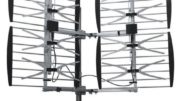The world of cord-cutting has many different types. Some want to save money, some want ultimate choice, and some just want “something different.” If you’re thinking of cutting the cord, have you thought about where you fit in?
What is cord-cutting?
The term “cord-cutting” or “cutting the cord” has been around for about a decade. It rose up because cable TV prices, once reasonable, became outrageous in the late 2000s just as the economy tanked. There were some good reasons why. Cable and satellite TV started in the 20th century as a way for people to get their local channels. Cable was big in fringe suburbs where putting up a big antenna was hard or impossible. The first cable systems had barely any national channels, because barely any existed.
By the 1980s and 1990s, the cable wars had started. Cable companies rushed to add national channels and keep prices low to entice new subscribers. After all, if you wired an entire town the only way to keep your prices low was to get a lot of subscribers. Satellite TV rose up originally in areas where cable didn’t exist, and because the cost of wiring was lower, subscribers got a great deal on a lot of channels.
Unfortunately things started to go a little sideways by 2000. Cable companies got fat, dumb and happy. Changes to FCC rules meant that they couldn’t pick up local channels for free anymore. More importantly, customers started to ask for features like DVRs, on-demand programming, and eventually high definition. Costs went up for the cable and satellite companies, and that meant costs went up for consumers too.
To fight this, a lot of pay-TV companies started piling on low-value channels like shopping, religious, and public interest channels. These channels actually kept costs down because they were cheap to carry and the pay-TV provider could make money selling commercials. However they proved to be very unpopular and reinforced the idea that there was something really messed up with the “value equation” of cable TV.
By the time the recession hit, a lot of folks felt like they were paying four times what they used to, and getting one-fourth of the satisfaction. And so, cord-cutting was born.
The hard-core cord-cutter
Those people who needed to save money fast formed the first wave of cord cutters. Cutting out the cable company completely and adding a TV antenna saves about $1200 a year, which was absolutely necessary for some families in the late ’00s. The hard-core cord-cutter relies on the dozens of free channels available over the air and perhaps a ready supply of DVDs.
This sort of cord cutter might even cut home internet out, preferring to use internet on a cell phone or tablet. New unlimited plans are making this more and more possible. You don’t have to pay for home internet if you’re not using it.
The streamer
Another type of cord-cutter who begin to arise in the early 2010s cut out the cable company, but kept the internet. This group tended to be a little younger, raised on the internet with very little traditional attachment to cable or satellite. They’ve been called “cord-nevers” because many of them have never had a cable or satellite subscription. They don’t watch much TV from broadcast networks and when they do, they use Hulu or another app to get it on demand.
For the streamer, obviously Netflix, Prime Video and other apps are the most important. Live TV takes a back seat. This sort of cord-cutter will have great internet service, or will rely on a neighbor who does. Many streamers will pirate movies or share passwords to online services as well in order to save money. It may not be legal, but that doesn’t seem to matter to them.
The cord-replacer
This is the newest category of cord-cutter. This is a person who is replacing a high-priced cable or satellite bill with a service like DIRECTV for Internet or Sling TV. These online services mimic traditional TV with live feeds, channel guides, and DVR service. They cost less than traditional pay TV and offer a much smaller selection of channels. You won’t find those “filler” channels on live streaming, and you’ll generally have a better selection of packages that let you tailor your viewing experience.
The cord-replacer looks to save money over time. Often times this is a person who has come off a “triple-play” bundle. After the initial term, cheap cable deals often get extremely expensive and customers look for other options. Live streaming services are perfect for them.
At first, this kind of cord-cutter was more likely to be an older person who had grown up on television. Today that’s still true but we’re seeing people of all ages get into live TV over streaming. That’s partially because of newer options like Sunday Ticket on YouTube TV. It’s also due to smaller cable companies pushing people toward live streaming instead of providing traditional cable service.
Need help or accessories?
Whether you’re a hard-core cord-cutter, a streamer, or a cord-replacer, you’ll find all the accessories you need, and all the advice you could ever ask for, by visiting SolidSignal.com. If you’d like advice on what to get in order to cut the cord your way, call us at 888-233-7563 or fill out the form below.





